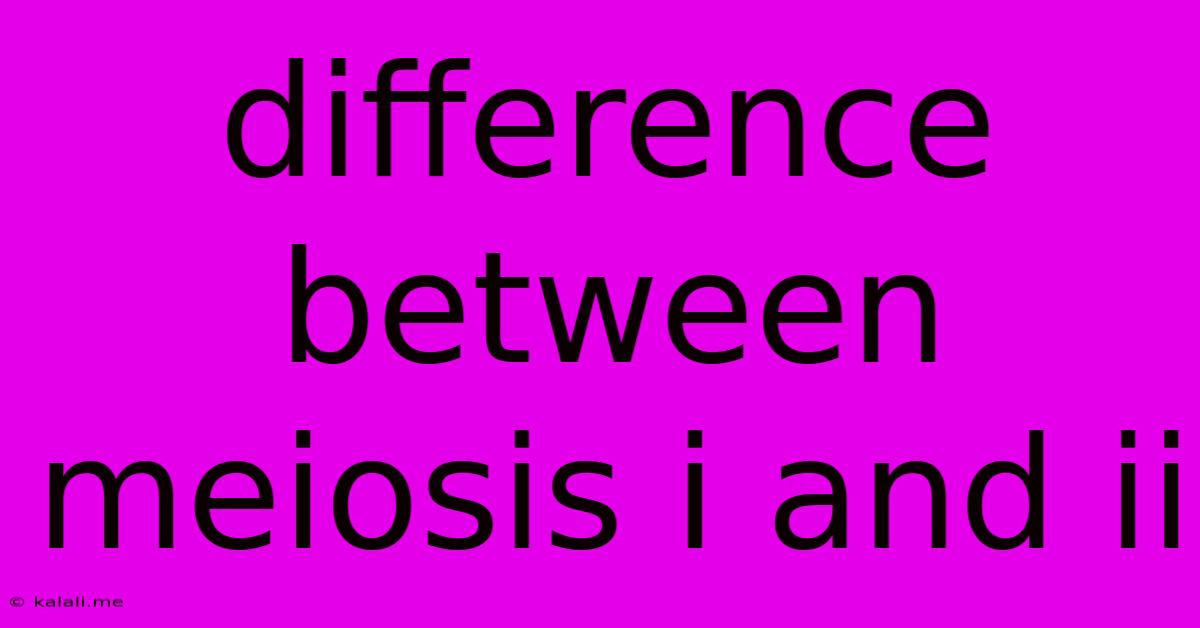Difference Between Meiosis I And Ii
Kalali
May 10, 2025 · 3 min read

Table of Contents
Meiosis I vs. Meiosis II: Understanding the Key Differences in Cell Division
Meiosis is a specialized type of cell division that reduces the chromosome number by half, creating four haploid cells from a single diploid cell. This process is crucial for sexual reproduction, ensuring genetic diversity in offspring. Meiosis is divided into two sequential divisions: Meiosis I and Meiosis II. While both involve similar stages (prophase, metaphase, anaphase, telophase), there are fundamental differences that distinguish them. Understanding these differences is key to grasping the mechanics of sexual reproduction and the inheritance of genetic traits.
What is the primary goal of Meiosis I vs. Meiosis II?
The primary goal of Meiosis I is to separate homologous chromosomes, reducing the chromosome number from diploid (2n) to haploid (n). This is achieved through a unique process of homologous chromosome pairing and recombination. In contrast, the primary goal of Meiosis II is to separate sister chromatids, similar to mitosis, resulting in four genetically distinct haploid daughter cells. Therefore, Meiosis I is the reductional division, while Meiosis II is the equational division.
Key Differences Between Meiosis I and Meiosis II:
| Feature | Meiosis I | Meiosis II |
|---|---|---|
| Chromosome Separation | Homologous chromosomes separate | Sister chromatids separate |
| Synapsis | Occurs during Prophase I (formation of tetrads) | Does not occur |
| Crossing Over | Occurs during Prophase I (genetic recombination) | Does not occur |
| Chromosome Number | Reduces chromosome number from 2n to n | Maintains chromosome number at n |
| Genetic Variation | High due to crossing over and independent assortment | Low, as genetic material is already shuffled in Meiosis I |
| Prophase | Longer and more complex; includes synapsis and crossing over | Shorter and simpler; similar to mitotic prophase |
| Metaphase | Homologous chromosome pairs align at the metaphase plate | Individual chromosomes align at the metaphase plate |
| Anaphase | Homologous chromosomes separate | Sister chromatids separate |
| Cytokinesis | Results in two haploid daughter cells | Results in four haploid daughter cells |
A Deeper Dive into the Differences:
Prophase I: This is where the most significant difference lies. In Meiosis I Prophase I, homologous chromosomes pair up in a process called synapsis. This pairing forms tetrads, structures containing four chromatids. During synapsis, crossing over occurs, exchanging genetic material between homologous chromosomes. This crucial step generates genetic diversity, creating unique combinations of alleles in the resulting gametes. Meiosis II Prophase II, on the other hand, is much shorter and lacks synapsis and crossing over. Chromosomes condense, but they do not pair with their homologs.
Metaphase I vs. Metaphase II: In Meiosis I Metaphase I, homologous chromosome pairs align at the metaphase plate. The orientation of each pair is random, a process known as independent assortment, contributing significantly to genetic variation. In Meiosis II Metaphase II, individual chromosomes (each consisting of two sister chromatids) align at the metaphase plate, similar to mitotic metaphase.
Anaphase I vs. Anaphase II: During Meiosis I Anaphase I, homologous chromosomes separate and move to opposite poles of the cell. Sister chromatids remain attached. In Meiosis II Anaphase II, sister chromatids finally separate and move to opposite poles, similar to mitotic anaphase.
In Conclusion:
Meiosis I and Meiosis II are distinct phases of a single process, but their roles in reducing chromosome number and generating genetic diversity are fundamentally different. Meiosis I is the reductional division, characterized by homologous chromosome separation, synapsis, crossing over, and independent assortment. Meiosis II is the equational division, resembling mitosis in its separation of sister chromatids, but operating on haploid cells. Understanding these distinctions is crucial for comprehending the intricacies of sexual reproduction and the inheritance of genetic traits.
Latest Posts
Latest Posts
-
What Is Half Of 1 And 3 4 Cup
Jul 02, 2025
-
How To Tell When Chorizo Is Done
Jul 02, 2025
-
Why Doesnt Christian Bale Remove His Mole
Jul 02, 2025
-
Somebody Once Told Me That The World Was Macaroni Lyrics
Jul 02, 2025
-
How Old Are You If Born In 1993
Jul 02, 2025
Related Post
Thank you for visiting our website which covers about Difference Between Meiosis I And Ii . We hope the information provided has been useful to you. Feel free to contact us if you have any questions or need further assistance. See you next time and don't miss to bookmark.